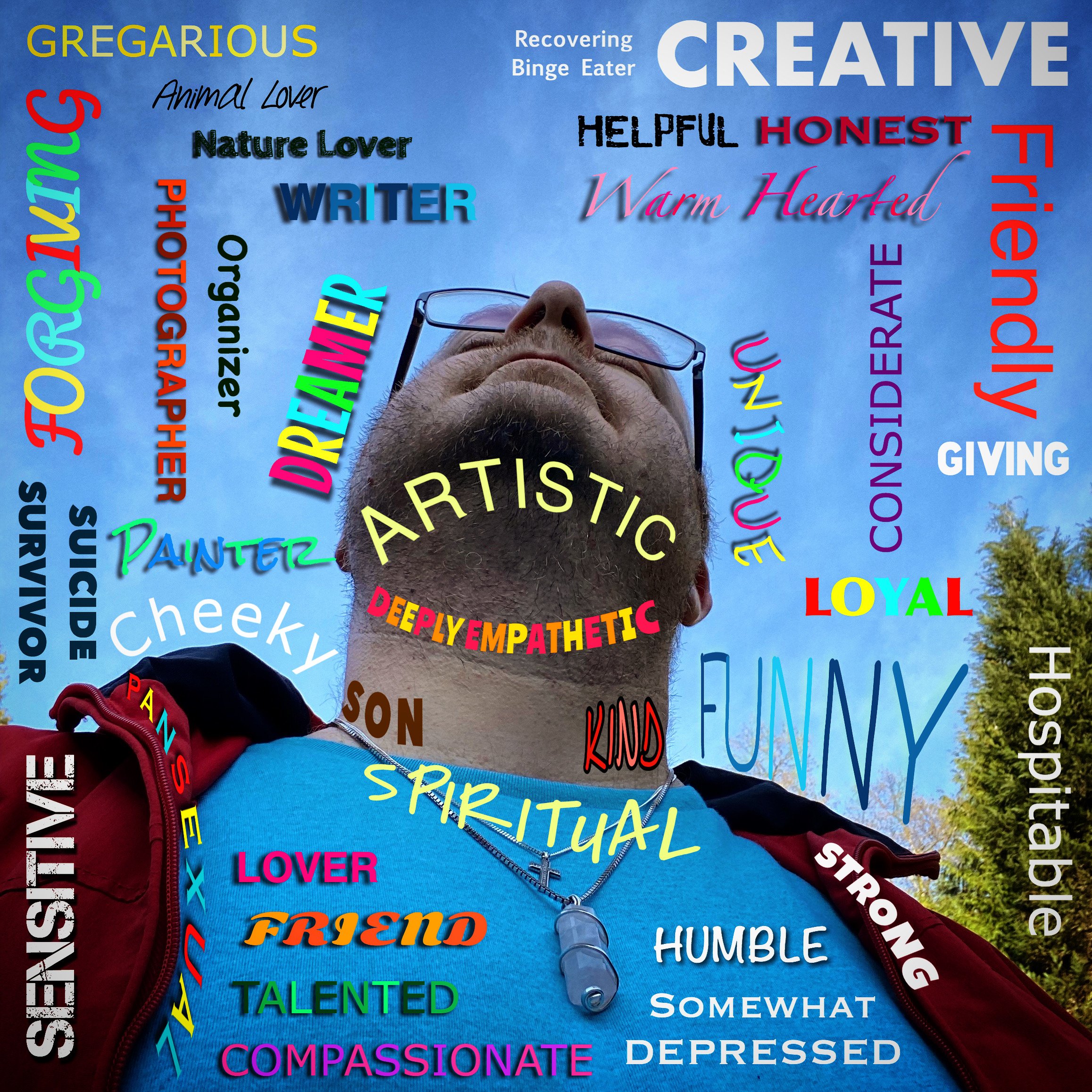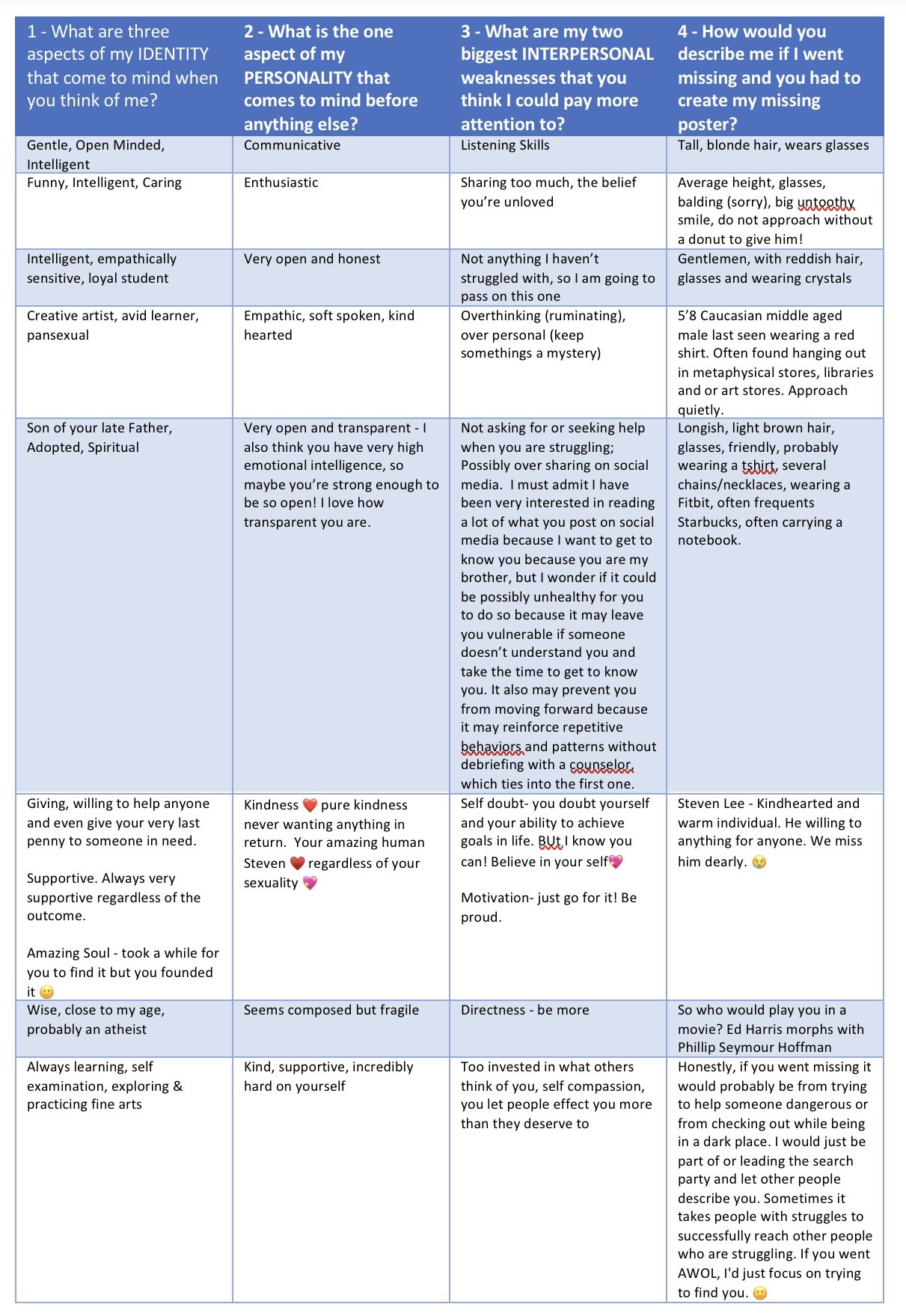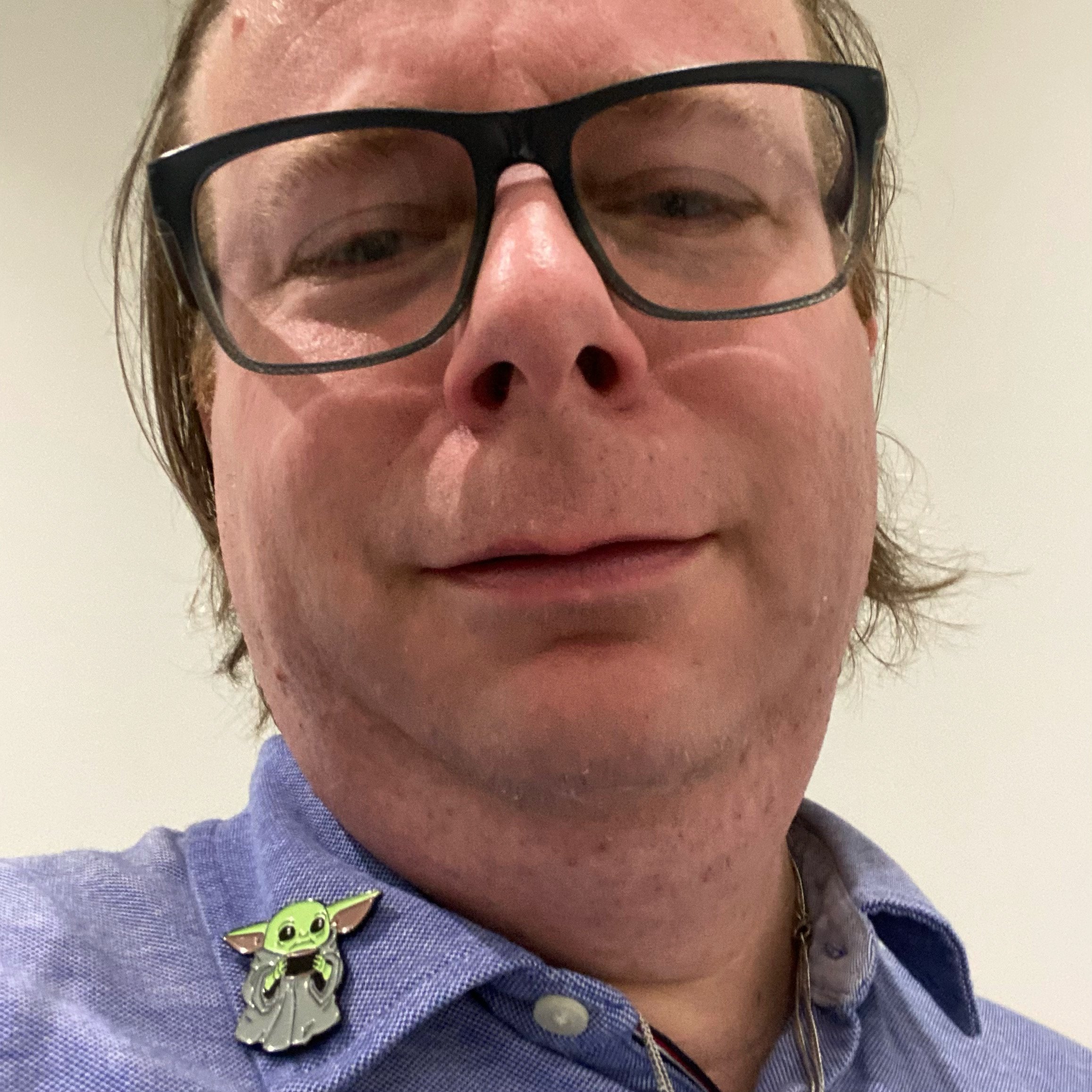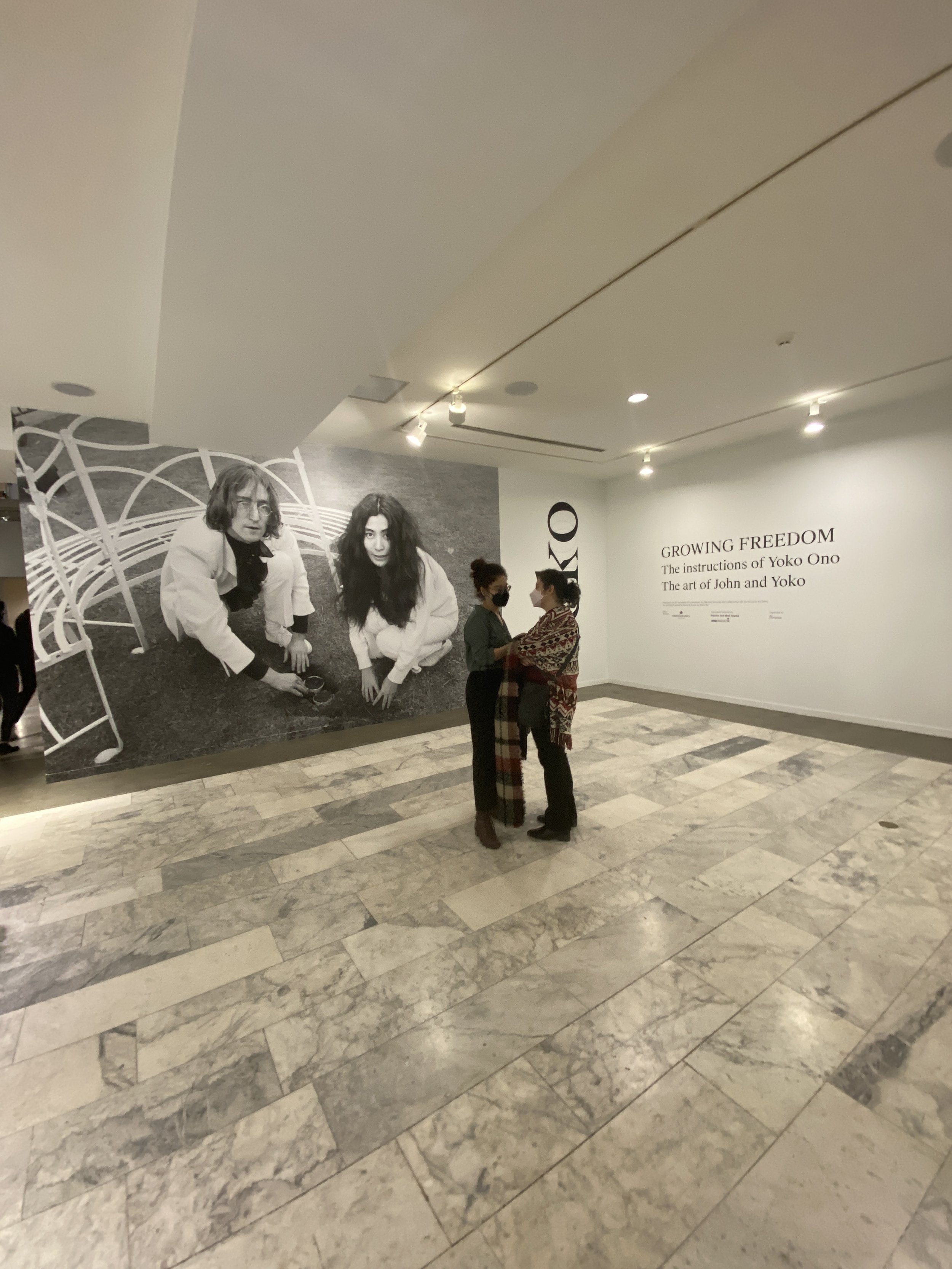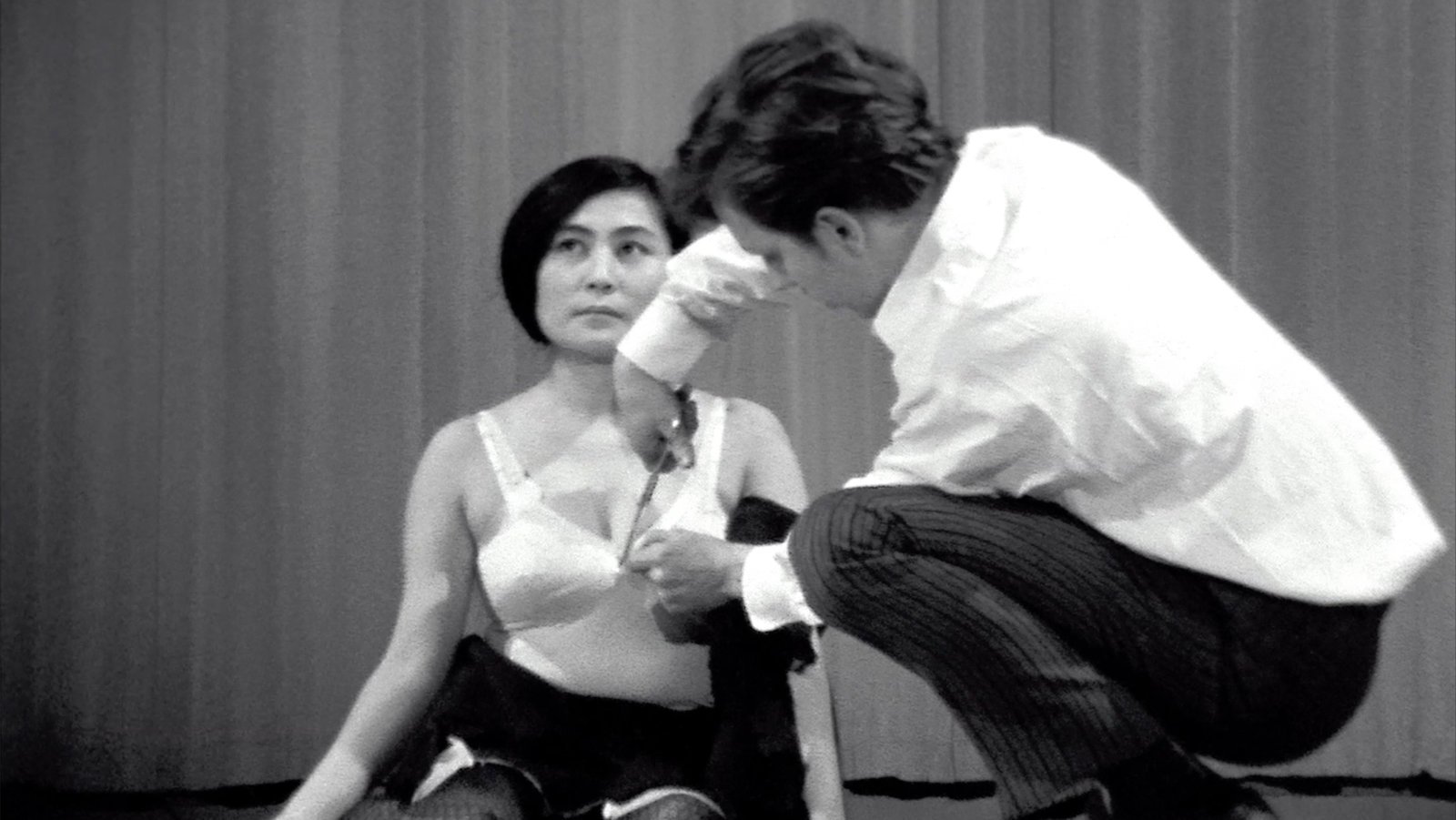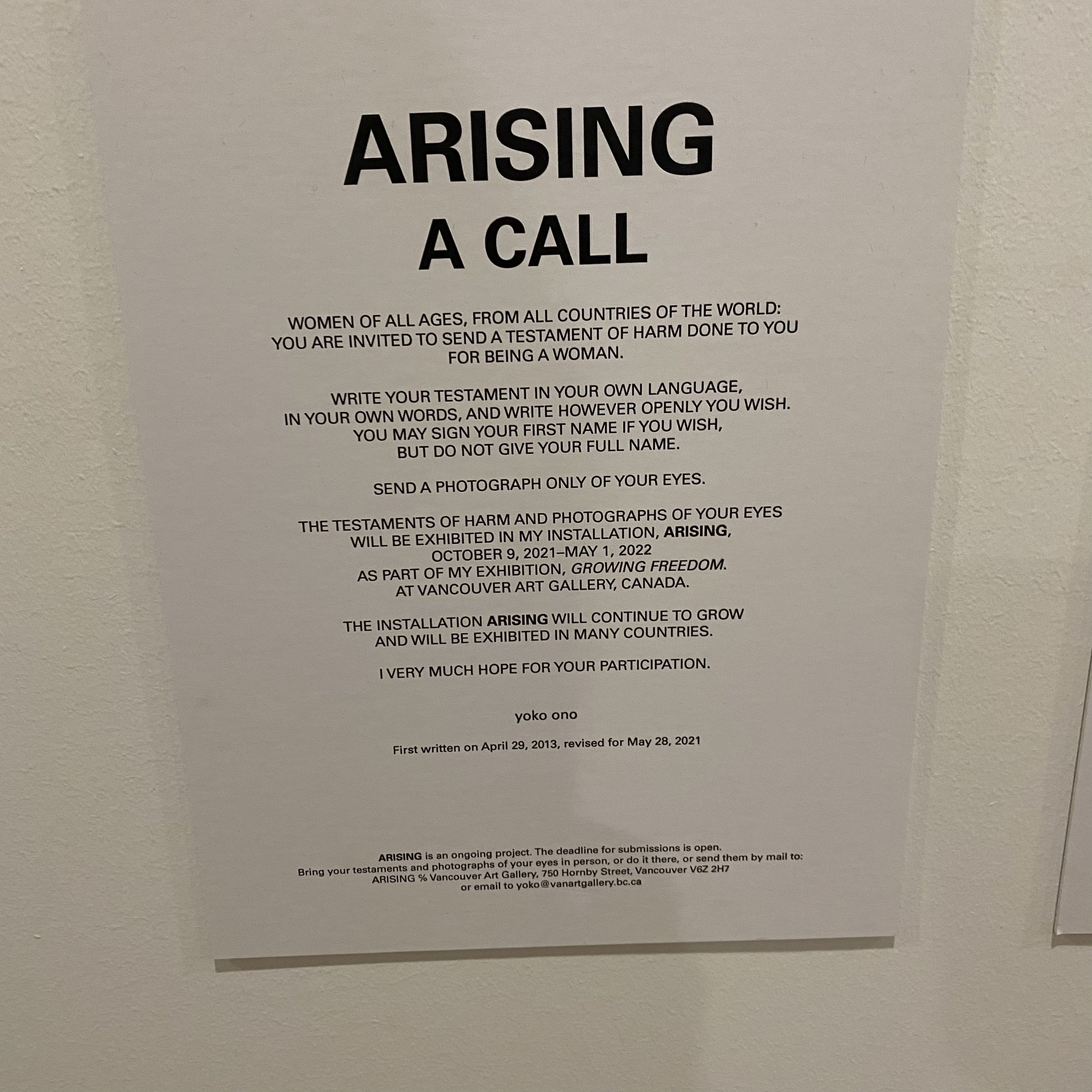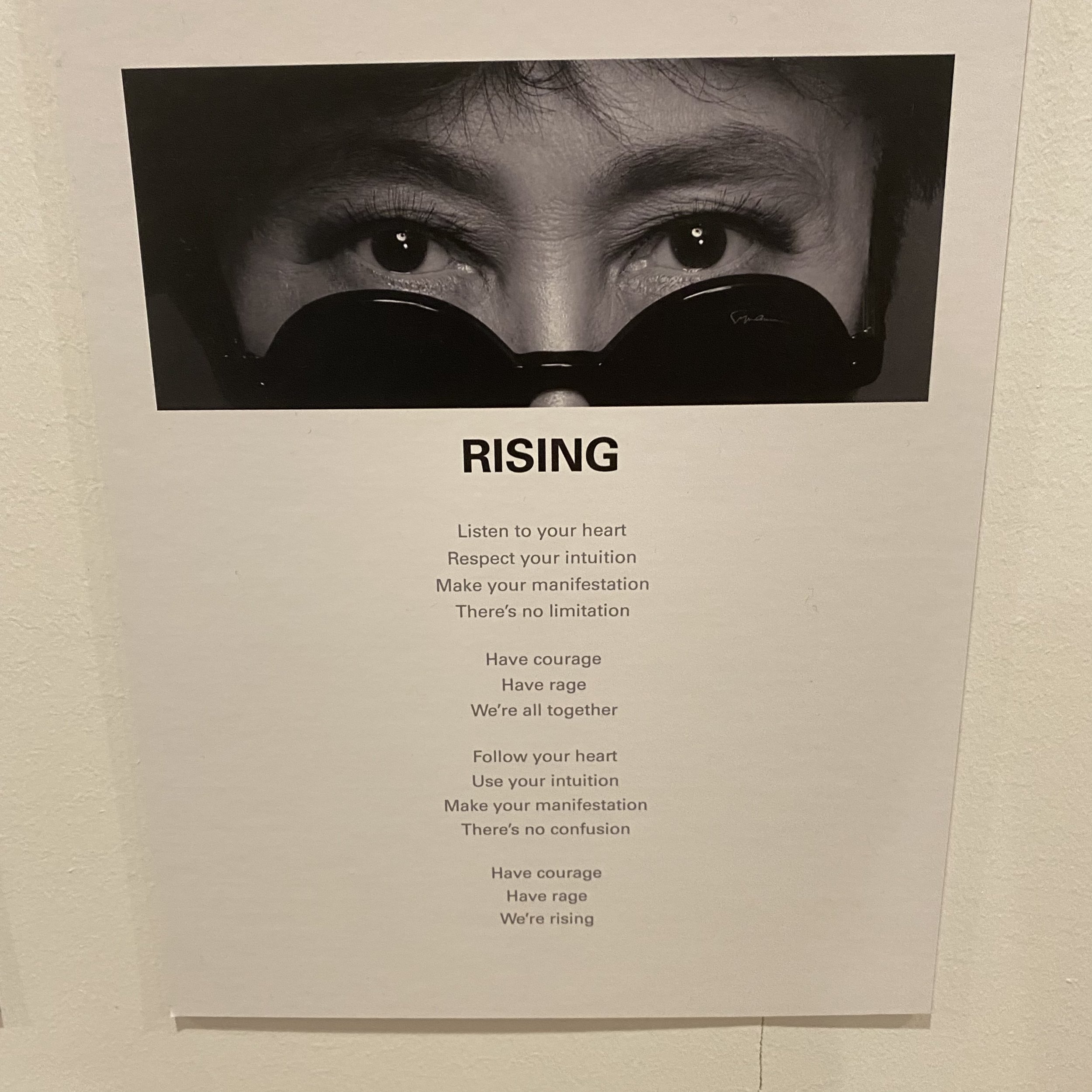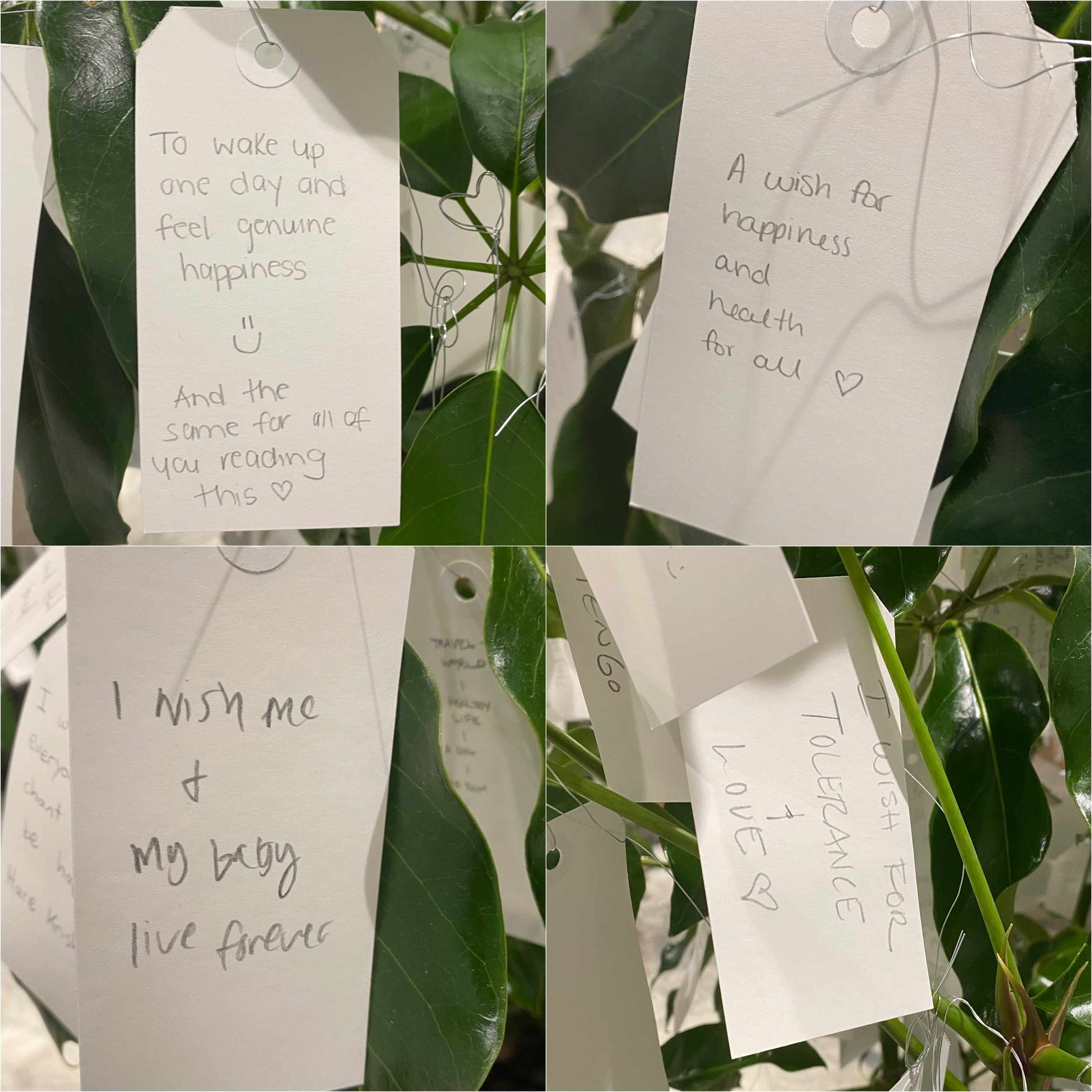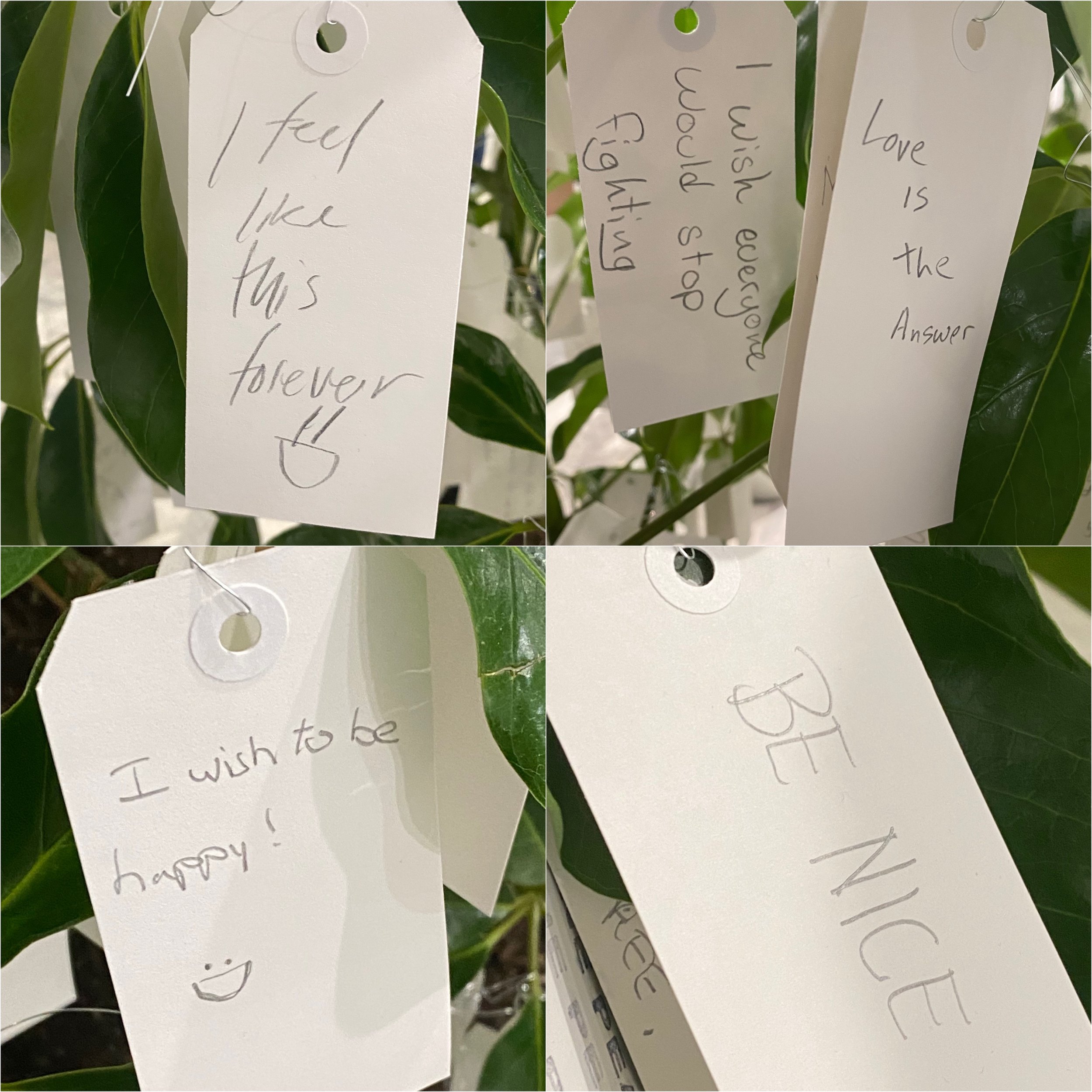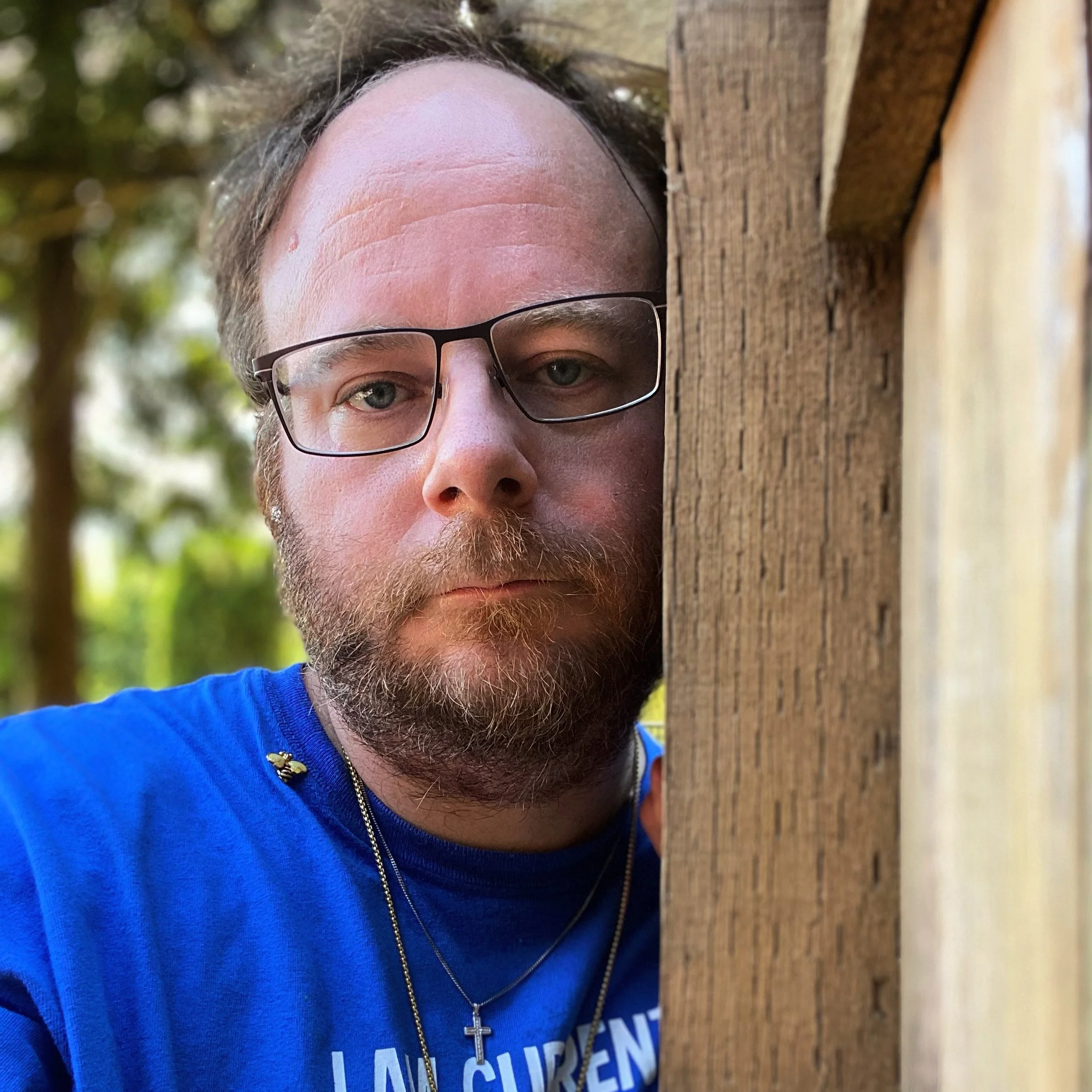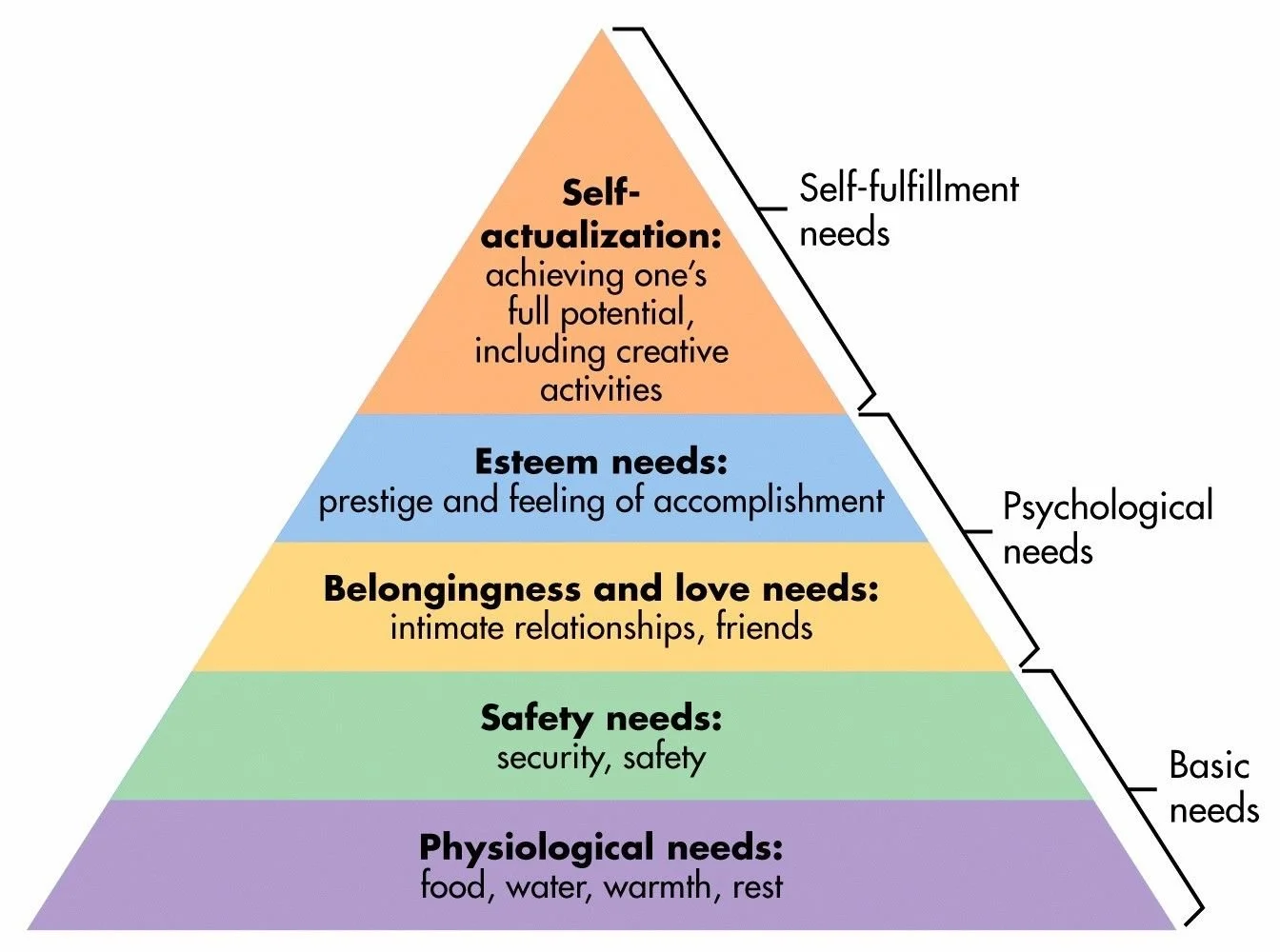Complete Field Study listed on p.38/39 of Jeffrey A. Kottler and Matt Englar-Carlson, Learning Group Leadership: An Experiential Approach. Sage, Third Edition, 2015, (exert below). After completing field study, reflect on the content of your interviews in the spirit of deepening your self-awareness and group leadership. Contemplate on appreciative ways of building on your passions and strengths as well as the transformative possibilities your areas of challenge offer.
2019 Identity & Personality Inquiry…
In 2019, while taking a Coursera workshop called Modern Art & Ideas, I was inspired by the work of artist Glenn Ligon, who, in 1993 asked ten friends how they saw him, instructing his friends to imagine that he’d gone missing and they were describing him as a missing person. Ligon then used those descriptions and printed them beneath 19th century images of slaves. So, I decided to play with the formal aspects of this idea in light of my own depression and insecurities about my sense of self, by asking several friends to identify three aspects of my identity, one aspect of my personality and to also describe me as if I was missing and they were helping to create my missing poster. I probably asked about forty friends, and got the following ten responses:
It was interesting to see which terms came up again and again across the various responses. Artistic and Funny were the top responses. And there were at least a dozen words related to the terminology of being kind and compassionate. Here’s a more detailed compilation:
Around that same time, I had made a post on Facebook that spoke in broad strokes about some personal issues I was having at the time. I got a lot of responses to that post, as follows:
You're a good guy, I hope you feel better soon and have a good week. Never mind those who disappear, enjoy the presence of those who stay. 😁
Huh?! You are the opposite of creepy. You are a wonderful person, kind, gentle hearted and warm.
I can relate to a lot of the qualities you say you carry. I am also sensitive about people liking me so i get it. You’re a kind and caring, generous person. Be yourself and don’t worry bout it. Sometimes people have different things going on and all you can do is say, hey, I’m here if you wanna talk about it, and then let it go, cause we can’t force others and sometimes people just need some space anyway. Keep doin you and focus on the things that make you happy peace and gratitude to you.
Get better soon, Steve. And don’t worry about what others think of you. Be yourself! You are a good person with a heart of gold and a great sense of humour. Be confident in the knowledge that you’re living a good life and those that matter love you.
I don’t find you put creepy energy out into the world at all. I found at Kwantlen for you to be one of the easiest people to approach and put out very funny, kind energy. It’s better to be a unique person. You’re not boring and like a carbon copy robot. The things that make you unique are special and definitely embrace it. It’s not easy though. I often worry if people like me or are annoyed by me because I can be a bit much sometimes. I think we all have self doubts and can get self conscious for sure.
One of the greatest things you can give yourself is to be okay with people's unpredictability and erratic behaviour - ie: have no expectations. Also more importantly: don't trust their judgement - ie: don't trust their opinions. Some people have extreme guards up because of trauma and as a result, are scared off by things that aren't typical - ex: off-humour and off-appearances. It's none of my business what their trauma is, nor do I pay it much attention. & A lot of people are extremely slow to warm up to others, you and I aren't some of them, but alas. A harsh reality is that no one owes you anything. =/ I wish I would've told my younger self to not get too involved with anyone and to just let friendships come and go and not have any expectations.
I remember you at Semiahmoo Secondary as being the kid who was different, but comfortably so. If you ever feel like taking a break from the "big city," let me know and come out to Hope and just chill out. I run a B and B, but my friends are FREE.
When I read what others say about me, I admit that I don’t always believe in it. My Monkey Mind has a tendency to focus on the worst of what people say about me, or to worry when someone was silent by not responding to my request to do the survey. In those cases, my mind wonders, “…why didn’t they respond? Do they have particularly harsh things to say about me that they’re afraid to tell me? Clearly they don’t like you Steven.”
April 2020 Photographic Composition
In April 2020, I was inspired to create a photo piece based on a piece I saw made by Sedona Jamieson in the UK, which itself was based on a campaign organized by I Weigh.
Specifically, the awareness campaign encouraged followers to document their journeys of growth and personal acceptance by:
Choosing an unedited photo of themselves;
Using Instagram, Tik Tok, pen and paper, Canva, or another editing tool;
Writing things that you value about yourself on top of the image – positive attributes that have nothing to do with your appearance; and
Sharing using #iweigh and tag @i_weigh.
I tweaked this by using the various descriptions that others had used to describe my identity and personality, and placing them onto my selfie, to create the following image:
The exercise of creating this image was really uplifting, and I was actually proud to share it widely. Neville Goddard once said how “The world is a mirror, reflecting what you are doing, within yourself.” As such, my rational mind knows that it must follow that if the world can see me in a positive light, I should be able to as well. But this hasn’t always been the case. Ultimately, I know I need to commit to reframing how I think about myself.
2022 Identity & Personality Inquiry…
In response to this assignment, I started by talking to a close friend of mine who lives in Europe. She was the first person I reached out to about exploring my interpersonal strengths and weaknesses this year, because I trusted her. I was able to talk to her about how I could approach this kind of project again, given my inclination towards shyness. She is someone I’ve known since 2020. We met through a Facebook group we were both a part of, and she eventually said this about my strengths, choosing to focus on my communication style, as we chat almost daily over text messaging:
Your strengths and weaknesses as a communicator... I'd say your strong suit is being expressive and knowledgeable. You are well read and that shows in the way you express yourself. Your opinions are pertinent and you always give arguments and/or quote your sources. You also have a great sense of humour and that adds to it.. a lot. You're open-minded and you love to learn and grow and that is also quite obvious every time you communicate your ideas. You are a positive presence and give off beautiful vibes. So even if, say, what you try to convey is not on the happy side, you do it respectfully and in a positive way.
In terms of my interpersonal weaknesses she said:
As your weaknesses… well, hope you don’t mind me being completely honest… I think I have those weaknesses too but let me explain.. I think it's sometimes jumping from one topic/idea to another. I' m not talking about your written pieces, as those are well-organized and you put so much thought and effort into them. I mean, your interactions.. Ours. You want to say a lot and I sometimes lose you because there's a lot to process. You pour your heart out. That's not bad, but it gets hard to follow at times. Another thing I' d like to mention, and again, I apologize for being blunt, is the way you monopolize the conversation at times.. I mean, I would like to be able to say more. That's all and I hope it'll help.
She also said this though, “Please don't change a thing about the way you interact with me. I appreciate you and our connection so much.” She feared I’d be upset by what she had said, even though I admitted I always feared I monopolized our conversations too much. I know I let her down this year, due to my depression at one point I feel I felt triggered, in general and not because of anything she said or did – and I ended up pulling back from our friendship. I didn’t respond to her for several months — I basically ghosted her. At one point I feared contacting her again, because I didn’t know how she would react. My Monkey Mind raced again – “She’ll crap on you. She’s so disappointed in you. She’ll never trust you again.” My mind thought this because this is a habit that I’ve fallen onto before – when I get overwhelmed, I pull back and don’t keep in touch. There’s been a few people I’ve let down by not talking to them for several years now. Over time, I’ve become aware of my need to pull back sometimes, and sometimes I am better at letting people know when I need some time alone. My feelings towards this today are also shaped by how I don’t like it when a message I’ve sent highlights how it has been “read,” but I hear nothing back. So it’s something I know I need to be more cognizant of. If I want to be heard, I need to listen better.
From my conversation with her, she touched on my monopolizing our conversation, and this is something that I know i have had a history of doing - going back to my days in the Kwantlen Student Association where I was able to get the Association to setup an online forum as a part of it’s website (this was just before the launch, or in the very early days of platforms like Facebook). Once setup though, I was overly enthusiastic about using it, and I know others felt I was monopolizing the platform by commenting on every post. More recently, a fellow classmate took my commenting on a few of her posts as me correcting her, and she took offence to that. This ties back to my friend who said I speak sometimes without thinking. It circles back to being more mindful. Am I being respectful of others who are authentically sharing? Am I really listening to what they have to say?
A former high school teacher of mine, provided some deeper insight. In terms of my strengths, he noted:
Well read, can quote any fantasy book you name, loyal to those who can listen, cares, really cares about people, loves his Mum.
This response made me think more in depth, because I know I haven’t always been the best son. There have been times in my past where I’ve not been as open and honest with her as I could be. For a time I lied about my financial situation. My issues with overspending has also resulted in me accumulating way too much stuff – leading to issues with organizing both my place and my Mom’s and keeping them clean, organized and functional. And depression impacts the overspending, and my overall health which I’ve also kept hidden from my Mother a lot. But there gets to a point where you can’t hide these things anymore. It’s an area when I still need to work on. In terms of my weaknesses, my former teacher noted:
I must admit that I think you share too much. Instead of daily updates on your mental health, try weekly or monthly – I would read more carefully if there was less. I guess that it’s a symptom of OC disorder. I care so much that I can share this with you.
And he’s not wrong. Several of the responses you will see below highlight this concern. It’s something I’ve been cognizant of. Especially in regards to how much I share. I feel it does make some people uncomfortable. Uncomfortable in that they don’t always know how to respond to it. Uncomfortable because we live in a society where we often keep things bottled up, especially in regards to issues such as depression. In terms of my subverted selfie project, I’ve always felt it was very important to be honest about how I feel everyday, as so many people’s instagram feeds are focussed on presenting a perfectly curated life – like a set of daily vacation style photos, that ignore the struggles people experience everyday. But I’ve always asked myself if what I’m posting is being authentic to how I’m feeling in that moment.
Another friend was also very forthright with her response to my query. Specifically, she described my personality as being:
…you. You are interesting, knowledgeable without being pompous and annoying. You are kind, at a moments notice you are ready to do a friend a favor. (Like picking me up from the ferry!) not just little things. You genuinely care about the folks around you.
She also lovingly described some areas of weakness I could work on. Specifically, she said:
Your issues are more being too self-effacing and perhaps too retiring. You could be more ready to interrupt and add your 2 bits worth. You are concerned about your physical appearance, and that is totally unneeded, Stop that! You are fine. No you don’t look ‘exactly’ like folks around you and I was fascinated to learn your nationality – but you don’t need to apologize for those differences.
You are dealing with huge HUGE home issues and these are seriously damaging your life. I don’t know what to do about that. I totally understand and sympathize, I also was sole care of my Mom. But there needs to be a point where you say, “you need to be in a care place!” I don’t think she needs a hospital type place but she needs more company and you need your freedom. (I know, easier said that done!!)
In support of this exercise, I decided to send out my 2019 questionnaire again, where I also added a question about what people felt were my biggest interpersonal weaknesses. The results have been really good to receive, and the ones about my weaknesses have also been good to read and really help to expand upon the first three questions I asked back in 2019. The results are as follows:
Again, as I saw in 2019, there were several terms that came up repeatedly across the various responses. Kindness, as well as being honest, open and transparent were all top responses. And once again, there were at least a dozen words related to the terminology of being kind and compassionate.
It was interesting to see funny didn’t make the cut this time as strongly as it did in 2019, and it did come up once as a weakness in terms of not always thinking about what I’m going to say. I know that people I’ve interacted with in recent years, primarily online, haven’t really experienced my sense of humour. My humour shines when I’m around people I know and trust, as it can be a part of my easy going nature. Humour for me is important, as it helps keep things lighthearted. It was pointed out in the 2019 survey that I can often be seen wearing funny shirts and this is something I do very purposefully. It’s often a way of breaking the ice before someone even approaches me – it puts them into a better mood, which is helpful for me as an empath. I often can pick up on other people’s energy, and when I’m struggling with my own depression, taking on the negativity or insecurities of others around me can pull me down even more. Granted, though, I am well aware that my humour at times can know no bounds. It can be a strength and weakness of mine, and as such it’s something I’ve been more cognizant of in recent years, especially around people who don’t know me.
The following are some responses by followers of my Facebook and Instagram feed, to my various subverted selfie project posts (whose photos and captions were included in my creative chapbook I made for this course). They read as follows:
I appreciate your transparency, many of us have a lot of work to do.
Every day is a chance to start over Steve. How about telling yourself, just for today, I will do the best I can.
My dude. I think you could use a change. Maybe travel to visit a friend somewhere. IDK. The description of your well-being sounds like some bad food habits that are coming due, but you could feel better in a few weeks of a different diet, and that would stick if you learned the habits to make it stick. I hope you feel better soon. You’ve paid your dues. It’s time to feel better.
You aren’t a joke. You matter, and it takes a real set to be so honest.
Why would you say you are a failure of a human being? Compared to what? Don’t be hard on yourself – there is enough crap in the world out there to do it to you. You are not a failure. I’d love to get down to 215 pounds! Depression is real, serious, and very, very common. You are not alone. Try and other doctor for another opinion / fresh eyes, and try to take each day one at a time.
I don’t see a joke. I see someone who is giving more energy to punishing themselves than the original missed goal ever required. Forgive yourself. You’re not doing anything different than most other people. The only difference is that we forgive ourselves.
Have you ever been looked at for ADHD, by any chance? I had a late life diagnosis, and learned that the symptoms we think are associated with it are often a common misconception. The most common symptoms include getting stuck, not being able to get things done, and not understanding why (and therefore, often feeling like a failure and / or lazy which can lead to depression and exacerbate existing symptoms). It’s just something to consider exploring if you haven’t before.
The mind is very powerful. Start with cutting half of your sugar intake, some exercise like going for a walk and meditation and yoga. Increase your water intake. You know these are healthy and even when you do not want to do it, push and do it. I definitely suggest weekly counselling, having a professional to talk to is very helpful for sure. I use essential oils for my mental health, if you need some info send me a PM. Writing negative things will not help. Perhaps if you want to vent you can write how you feel and turn it into something positive at the end. “The day is not finished, let’s now get up and have a shower, I will start the day again… tomorrow is a new day, I will do 1% better.” I wish you well.
Steve, I have not seen you for many years, but always found you to be a kind, considerate, and smart man. Periods of self doubt, and also of disassociation from others is a sign that you need to have some sort of radical change in life. Over the years, a good friend of mine took a walk down along East Hastings.
Accept where you are, love where you are.
Dude – good job. Cleaning when in the depression trenches is no joke! Do something nice for yourself.
I love how you write. I wish you success and self love.
The expectations we impose on ourselves, that we perceive to be imposed by others, can be brutal and suffocating.
There is no such thing as a failure. We are all on a journey and sometimes that journey is so hard. But those hard times do not last forever. We learn form each decision. The “failures” are where we learn our best lessons. Were we make our largest leaps in growth and knowledge, but that takes time. Hugs my friend. Be kind to yourself.
True, knowing what you should do and being able to do it are different planets. But we are what we have practiced. That can be depressing or cause for optimism.
Tackle things one step at a time. Looking at everything like that is too overwhelming.
Steven, know that all those thoughts of self hate and no self worth is the depression talking. It isn’t you. I know this because I went through it and now I’m out of it, and can see my previous thoughts while I was depressed as depression talking, not actually you.
We all have our flaws. We’re all not perfect. You’re stronger than you can even imagine for noticing these tendencies which you may exhibit and that is 90% of change for life wellness. Also, you might be blowing things up bigger than they may really be. It happens to me sometimes, happens to the best of us.
Hey Steven, I definitely resonate with this. I’ve noticed a lot of negative traits myself when I look up articles, but many of them come from trying to survive in a pretty toxic environment growing up. Trauma, especially when it started early in life, can have us display lots of unhealthy traits, and in my experience none of these pop psychology articles take trauma into account. It’s a big blind spot for our culture and so many articles take a lot of these things to extremes and label people with some disorder without any empathy for their experience. Most “evil” or toxic people in my opinion have had trauma and have maladaptive behaviours to deal with life which usually started at an early age. I don’t really believe most people are evil but we can easily react to these things and think it means where horrible people, but these articles are made to get clicks and what better way to do that then post to a really scary title to trigger us? I find that working on my inner issues like trauma gets me moving in the right direction, and no longer paying attention to the extreme articles out there. People with trauma will often have very negative beliefs of her themselves and think they are bad people so it can be all too easy to look at a negative article music as evidence to “confirm” I believe about ourselves. I hope this helps and just know you’re not alone. I do the same thing every time I read any article, like a hypochondriac. I just need to let some of that stuff go, and not give it as much attention. Remember that you’re a good person and you will find evidence of it.
Steve, next time you stumble across a video that suggests to have the goods on anyone topic, give it a skip or take it as entertainment. The fact that you have a sense of remorse pretty much crushes off being a sociopath. That said, in my personal experience you were out of the running for Ivo. If you see you could shape up and fly right, then heading that direction. Call my phone built in a day. Baby steps. Then get back taking photos, especially in nature spaces, to walk in the fresh air will always put you in a better state of mind. Nature is healing and brings us to a better place. It’s about balance.
Hopefully will continue to get stronger in the new year! Loving yourself for who you are as the most important first step. You are so gifted in so many ways. Use those gifts to show yourself you can do this! No one is perfect! Everyone always find something to criticize them selves about. Dwell on your strengths as a caring, loving person who tries to help others.
You are a fabulous writer and have a gift.
With many of these responses, I admit that I didn’t always take the time to respond to each person. I’ve found this is the case because often I post something but the process of just writing one of my subverted selfies can be draining sometimes and I don’t have the energy to go back right away and read the various comments. So as I compiled the above list, I made it a point to respond to most of the comments, thanking the individuals who left the comments and explaining why I sometimes ghost the comments sections of my posts. This is definitely another weakness of mine – I believe in the power that social media can have in terms of providing a vehicle by which people can discuss important issues, but then I don’t often show up fully when I post my own content. It’s not like I’m super famous on social media either… so the numbers of people who interact with my posts isn’t very high.
From these comments too, I know too that I really need to work on my mindfulness practice. My emotional awareness is often very acute and accurate. I definitely am aware of how I feel, moment to moment, for most of the time during each and every day I’m fortunate enough to walk upon this planet. Where I falter is in looking at what I feel with a bit of reserved detachment - that is, I fail to look at how I feel with a non-judgmental eye. I’m always so quick to judge myself, often harshly. Conan O’Brian, in a clip posted on the i-Weigh instagram page, described “…depression as being anger turned inward.” Or in more extreme cases, “rage turned inward.” And I know I need to stop turning my own anger towards myself. I need to find ways to positively release it, so I don’t dwell on it, and so that I don’t let it continue to hurt myself or others in my life.



